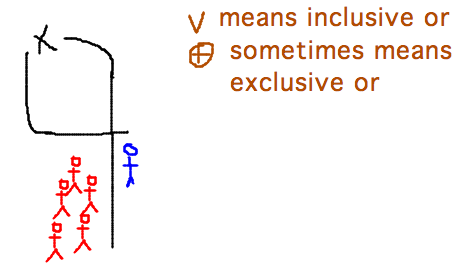Misc
GROW STEM implicit bias workshop: Tuesday, Jan. 31, Milne 104, 5:00 - 7:00 PM
Guideline for using prior results in homework or in-class proofs: If Sundstrom proves it in the body of his text prior to when the question comes up in class, or we proved it in class, you can use it without redoing the proof. For example (totally coincidental, of course), Sundstrom proves that the product of 2 odd integers is odd in his Theorem 1.8, which goes with material we have covered by now, so you could use that theorem to justify a step in the proofs from the current problem set.
Questions?
Distinction between necessary and sufficient?
Suppose “if P then Q” is a true statement.
And further suppose P is true, so Q must also be true.
Thus, knowing that P is true is sufficient to conclude that Q is true (but there might be other reasons why Q could be true too, so P does not necessarily have to be true in order for Q to be — i.e., “sufficient” and “necessary” are not the same)
But Q is necessarily true whenever P is
So “if P then Q” is equivalent to “P is sufficient for Q” and to “Q is necessary for P” (although this last wording is odd in English, because it sounds like it ought to mean that Q somehow causes P to be true — maybe “Q is necessary from P,” i.e., “Q necessarily follows from P,” would sound better).
We can also say P is true only if Q is also true (again, this wording might sound in English like it should mean Q is the only thing that causes P to be true, but that’s not how to read it — it simply means that P cannot be true without Q also being true).
Compare all of the above to “P if and only if Q,” which is a two-way implication: P implies Q and Q implies P.
Compound Statements
Find examples of true “real world” statements using “and,” “or,” or “not”; similarly for false real world statements.
Relevant ideas from section 2.1
- Statements can be represented by variables with which you can do logic
- Logical functions (aka connectives) include
- not: not R is true when R is false and vice versa
- Conjunction (and): P and Q is true only if both P and Q are true
- Disjunction (or): P or Q is true unless both P and Q are false, and therefore true when both are true
- Conditional: covered before
For example, a true statement “I am in Math 239 and I’m in South 328”
A false statement (at least for students in this section) “I am in Math 239 but I’m not in South 328.” Notice that “but” and “and” are the same connective logically.
The book’s example of something that uses “or”: “at the intersection you can turn left or go straight.” The book uses this as an example of “exclusive or,” i.e., a single person will never both go left and go straight. But the “or” could also be inclusive if “you” referred to a group of people: then the whole group could go left, or the whole group could go straight, or the group could split and go both ways.

Next
Truth tables
Logical equivalence
Read section 2.2